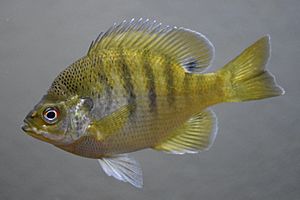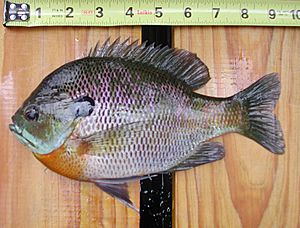Bluegill facts for kids
Quick facts for kids Bluegill |
|
|---|---|
 |
|
| Conservation status | |
| Scientific classification | |
| Synonyms | |
|
Lepomis purpurescens Cope, 1870 |
The bluegill (Lepomis macrochirus) is a type of freshwater fish. People sometimes call it "bream," "brim," "sunny," or "copper nose." It belongs to the sunfish family called Centrarchidae. This family is part of the order Perciformes.
Bluegills are originally from North America. They live in streams, rivers, lakes, and ponds. You can often find them east of the Rocky Mountains. They like to hide around old tree stumps and other things underwater. Bluegills can live in deep or shallow water. They often move between these spots depending on the time of day or season. They also like to find shelter among aquatic plants and in the shade of trees along riverbanks.
Bluegills can grow up to 12 inches (30 cm) long. They can weigh about 4+1⁄2 pounds (2.0 kg). Their color can change a bit, but they usually have special markings. Their face and gill cover are deep blue and purple. They have dark olive-colored bands on their sides. Their belly is often a fiery orange to yellow. Bluegills eat many different things, mostly small water insects and fish. They are an important part of the food chain. Bigger fish like bass and northern pike eat them. Birds like herons and kingfishers also hunt them.
Contents
What Makes a Bluegill Special?

The bluegill has a special black spot on each side. This spot is near the back edge of its gills and at the base of its dorsal fin. People often call this spot the "ear." The sides of its head and chin are usually a dark blue color. The exact color can change because of special cells under its skin.
When a bluegill is caught, it often shows 5–9 dark stripes on its sides. This is part of its way to show it feels threatened. It usually has a yellowish chest and belly. During breeding season, the male's chest turns a bright orange. Bluegills have a flat, deep body. They have a small mouth and ctenoid scales. They also have a lateral line that helps them feel vibrations in the water.
Bluegills are usually about four to 12 inches long. The biggest one ever caught was over 16 inches long. The largest bluegill ever caught weighed four pounds, 12 ounces in 1950. Bluegills are very similar to the orangespotted sunfish and the redear sunfish. However, bluegills have a clear spot near the base of their soft dorsal fin.
Where Do Bluegills Live?
Bluegills naturally live in the United States east of the Rocky Mountains. They are found from coastal Virginia down to Florida. They also live west to Texas and northern Mexico, and north to western Minnesota and western New York.
Today, bluegills have been moved to almost every other part of North America. They have also been introduced to places like Europe, South Africa, Zimbabwe, Asia, South America, and Oceania. Bluegills have even been found in the Chesapeake Bay. This shows they can handle a little bit of salty water.
In some places where they were introduced, bluegills are now considered a problem. For example, it is against the law to trade them in Germany and Japan. In Japan, bluegills were given as a gift in 1960. They escaped from research places and became an invasive species. This means they harmed the native fish, especially in Lake Biwa.
Bluegills live in the shallow parts of many lakes and ponds. They also live in streams, creeks, and rivers. They like water with lots of aquatic plants. They hide inside or near fallen logs, water weeds, or any other underwater structure. You can often find them around beds of weeds where they look for food or spawn. In the summer, adult bluegills move to deep, open water. They float just below the surface and eat tiny water creatures.
Bluegills try to stay in water that is 60 to 80 °F (16 to 27 °C). They usually have a home area of about 320 square feet (30 m2) when they are not breeding. They like warmth but not direct sunlight. They often live in deeper water but will come closer to the surface in the morning to warm up. Bluegills are usually found in groups of 10 to 20 fish. These groups often include other panfish like crappie and pumpkinseeds.
What Do Bluegills Eat?
Young bluegills eat very tiny creatures like rotifers and water fleas. Adult bluegills eat insect larvae that live in water. These include mayflies, caddisflies, and dragonflies. They also eat tiny zooplankton, shrimp, crayfish, leeches, snails, and other small fish. If there isn't much food, bluegills will also eat water plants and algae. If food is really scarce, they might even eat their own eggs or babies.
Bluegills spend a lot of time near the water's surface. This means they can also eat bugs that land on the water. Most bluegills eat during the day. They eat the most in the morning and evening, with the biggest meal usually in the evening. They choose where to eat based on how much food is there and how many predators are around. Bluegills use special filters in their gills and small teeth to eat their food. In summer, they eat about 3.2 percent of their body weight each day. To catch food, bluegills suck water into their mouths. The food comes in with the water. They can only suck in a small amount of water, so they must get very close to their prey.
Who Eats Bluegills?
Many larger animals eat bluegills. These include big fish like largemouth bass, smallmouth bass, striped bass, trout, muskellunge, northern pike, and walleye. Turtles and even bigger bluegills also eat them. Birds like herons and kingfishers catch bluegills in shallow water. Otters also hunt them. However, the flat shape of the bluegill makes them hard for some predators to swallow. Raccoons are also thought to be predators of bluegills.
How Do Bluegills Move?
Bluegills can swim and change directions very quickly. They do this by moving their fins together. They use their tail fin, soft dorsal fins, and body wiggles to move forward. Their tail fin helps them speed up fast. The speed depends on how strongly they move their fins. The bluegill's flat, thin body helps it cut through the water easily. Their large, flexible pectoral fins help them slow down quickly. This amazing ability to move helps bluegills find food and escape from predators very well.
Bluegills have a lateral line system and inner ears. These help them feel vibrations and changes in water pressure. But bluegills mostly use their sight to find food, especially during the day. Their best vision is in daylight hours. The bluegill's mouth is very small. It uses its throat to suck in its prey.
Swimming Forward and Backward
The bluegill relies a lot on its flexible fins to move well in water. The way its pectoral fin rays are divided helps it deal with water forces. Bluegills have special ways to move in different places. If a bluegill can't see or use its lateral line, it uses its pectoral fins to navigate. The fins bend when the fish touches something. This helps them feel their way around.
When swimming forward slowly, the bluegill uses its caudal (tail) fin, dorsal fin, and anal fin. The tail fin muscles are important for slow swimming and for starting to swim faster. The dorsal and anal fins work together to keep the fish balanced when swimming steadily.
When swimming backward, the bluegill uses many different fin muscles. Swimming backward is more complex than swimming forward. It's not just the reverse of forward swimming. The fish uses its pectoral fins to create a rhythmic beat. The dorsal and anal fins help push the fish backward. The pectoral fins' beat is uneven. This helps the fish balance during its slow, backward movement.
Mixing with Other Fish Species
Sometimes, a bluegill might breed with another fish from its same group, called Lepomis. This is rare. It usually happens in isolated ponds where there are many bluegills and a smaller group of other Lepomis species, like green sunfish. If there are not many places to build nests, females of one species might choose the nest of another. Bluegills could theoretically breed with all other species in the Lepomis group. However, the most common mix is with the greengill.
Bluegills and People
The bluegill is the state fish of Illinois.
Fishing for Bluegills

Bluegills are popular fish to catch and eat. People call them "panfish" because they fit well in a frying pan. Fishermen catch them with live bait like worms, crickets, or grasshoppers. They also use flies, small minnows, or maggots. Some people use small shrimp bits, bread, corn, or even a bare hook. Bluegills often bite on bright colors like orange, yellow, green, or red. They are most active at dawn and dusk.
Bluegills like to hide in underwater plants. Their natural diet includes crickets, water bugs, insect larvae, and very small fish. Bluegills are also used as bait for bigger game fish. These include blue catfish, flathead catfish, and largemouth bass.
Fishermen sometimes wear special sunglasses to see through the water. This helps them find bluegills' nesting spots. Bluegills can be quite brave. Many are not afraid of humans. They will eat food dropped into the water. In Canada's Lake Scugog, some bluegills even let people touch them!
The world record for the largest bluegill ever caught was 2.15 kg (4 lb 12 oz). It was caught in Ketona Lake in Alabama in 1950.
Managing Bluegill Populations
Bluegill populations can be affected by fishing. Large male bluegills are especially easy to catch. This is because they guard their nests in the middle of fish groups. It's becoming harder to find places with many large male bluegills. They are usually found in remote areas without much fishing or in warmer southern regions where they grow faster. Limiting how many fish people can catch might help improve the size of bluegills in places where too many are caught.
Bluegills are important for managing ponds and lakes. They help keep the number of crustaceans and insects low. A single group of bluegills can eat up to six times its own weight in just one summer!
Images for kids




